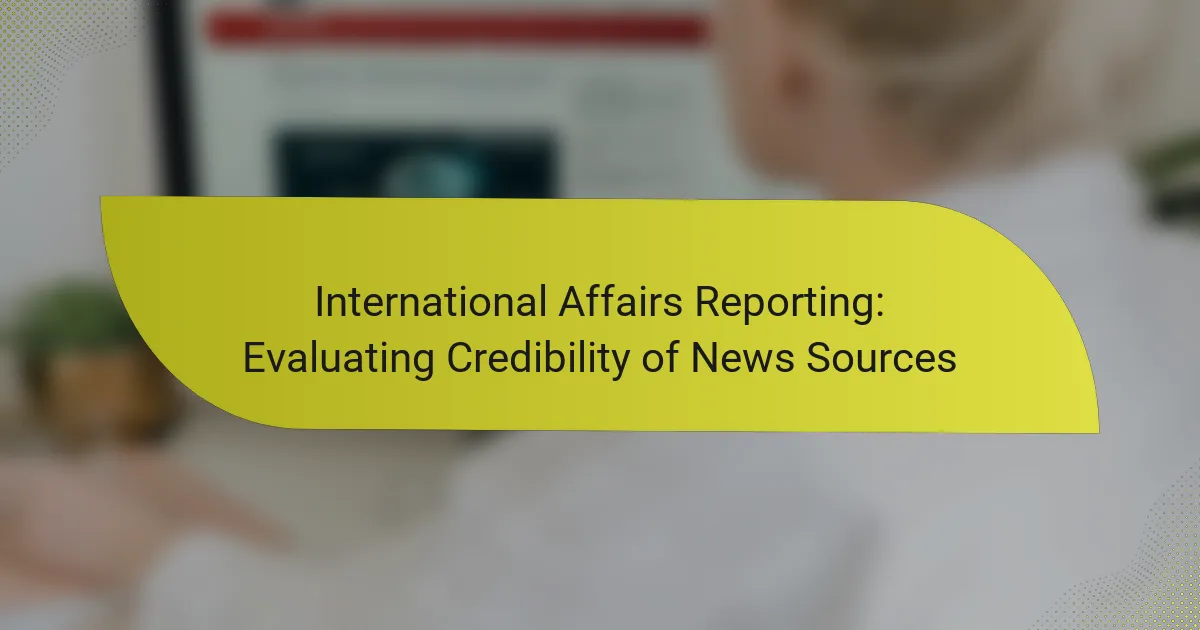In today’s interconnected world, evaluating the credibility of international news sources is essential for informed decision-making. By analyzing factors such as author qualifications, editorial standards, and source citations, readers can differentiate between reliable reporting and biased narratives. Understanding these elements is crucial, as bias can significantly shape public perception of global events and issues.

How to evaluate the credibility of international news sources
Evaluating the credibility of international news sources involves assessing their reliability, accuracy, and transparency. By employing specific strategies, you can discern trustworthy information from biased or misleading reports.
Fact-checking organizations
Fact-checking organizations play a crucial role in verifying the accuracy of news claims. Reputable entities like Snopes, PolitiFact, and FactCheck.org assess the truthfulness of statements made in the media. When evaluating a news source, check if they cite findings from these organizations to support their claims.
Look for fact-checking labels or links within articles, which indicate that the information has been independently verified. This can enhance your confidence in the news source’s credibility.
Cross-referencing multiple sources
Cross-referencing multiple news sources is essential for verifying information. When a story is reported by various outlets, especially those with different editorial perspectives, it is more likely to be accurate. Aim to consult at least three distinct sources to get a well-rounded view of the event.
Be cautious of echo chambers where similar viewpoints dominate. Seek out sources from different countries or regions to gain a broader perspective on international affairs.
Analyzing source transparency
Transparency in sourcing is a key indicator of credibility. Reliable news organizations typically disclose their sources, methodologies, and potential conflicts of interest. Check if the news outlet provides information about its editorial standards and the qualifications of its journalists.
Look for articles that include citations, links to original documents, or interviews with experts. If a source is vague about its information or lacks accountability, it may be less trustworthy.
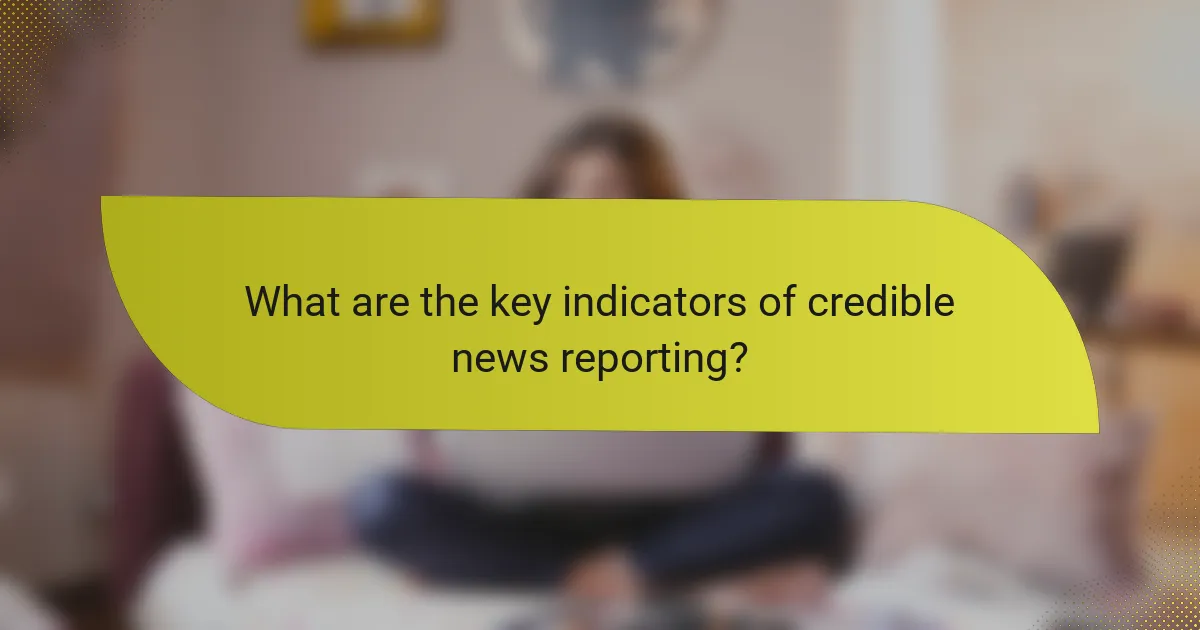
What are the key indicators of credible news reporting?
Key indicators of credible news reporting include the qualifications of the author, the editorial standards upheld by the publication, and the presence of reliable source citations. Evaluating these factors helps readers discern trustworthy information from misinformation.
Author expertise and background
The author’s expertise and background are crucial in assessing credibility. Look for authors who have relevant education, experience, or professional affiliations in the subject matter they cover. For instance, a journalist specializing in international affairs should ideally have a background in political science or international relations.
Additionally, consider the author’s track record. Established journalists with a history of accurate reporting are generally more reliable than those with little experience. Checking their previous work can provide insight into their credibility.
Editorial standards and practices
Editorial standards and practices reflect a publication’s commitment to accuracy and integrity. Credible news outlets typically have clear guidelines for fact-checking, sourcing, and corrections. Look for publications that are transparent about their editorial processes.
Reputable organizations often adhere to industry standards, such as those set by the Society of Professional Journalists (SPJ) or the International Federation of Journalists (IFJ). These standards promote ethical reporting and accountability, which are vital for maintaining credibility.
Source citations and references
Source citations and references are essential for verifying the information presented in news articles. Credible reporting should include citations from reliable sources, such as government reports, academic studies, or expert interviews. This allows readers to trace the information back to its origin.
When evaluating an article, check for the presence of hyperlinks or footnotes that lead to original sources. Articles that lack citations or rely heavily on anonymous sources may indicate a lower level of credibility. Always prioritize articles that provide clear and accessible references.
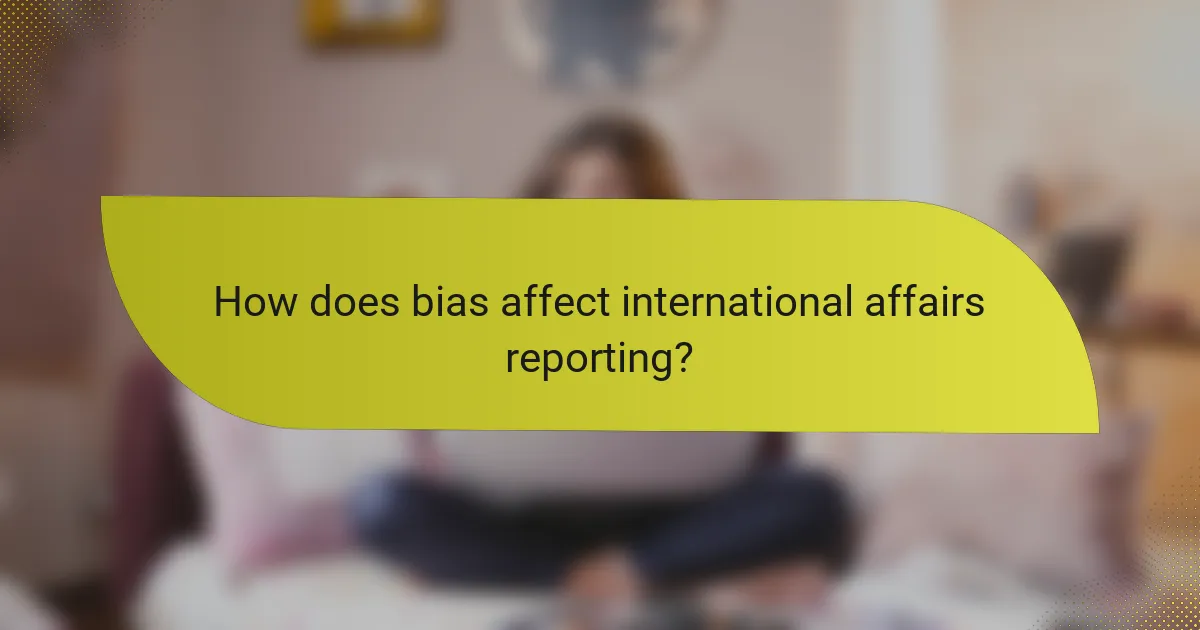
How does bias affect international affairs reporting?
Bias significantly influences international affairs reporting by shaping the narrative and framing of events. It can lead to selective emphasis on certain facts while downplaying others, ultimately affecting public perception and understanding of global issues.
Identifying political affiliations
Recognizing the political affiliations of news sources is crucial for evaluating their credibility. Media outlets often have ideological leanings that can color their reporting, particularly on sensitive international topics. For instance, a news organization with a conservative bias may focus on issues that align with right-leaning perspectives, while a liberal outlet might highlight different aspects.
To assess bias, consider the ownership of the media outlet, its editorial policies, and the backgrounds of its journalists. Tools like media bias charts can help visualize where a source falls on the political spectrum, aiding in the identification of potential biases.
Understanding cultural perspectives
Cultural perspectives play a significant role in shaping international affairs reporting. Different cultures prioritize various issues based on historical context, societal values, and national interests, which can lead to divergent narratives about the same event. For example, Western media might report on a conflict with a focus on human rights, while media from the affected region may emphasize sovereignty and national security.
To navigate these differences, it is essential to consume news from diverse sources across cultures. This approach helps to build a more comprehensive understanding of global events and mitigates the risk of being swayed by a single narrative. Engaging with international news from various regions can provide a richer, more nuanced view of complex issues.

What tools can assist in assessing news credibility?
Several tools can help evaluate the credibility of news sources, enhancing your ability to discern reliable information. Utilizing resources like media bias charts and fact-checking websites can provide insights into the reliability and objectivity of various news outlets.
Media bias charts
Media bias charts visually represent the political bias and reliability of news sources, helping users quickly assess where a particular outlet stands. These charts typically categorize sources on a spectrum from left to right, along with a reliability scale from low to high.
When using media bias charts, consider the source of the chart itself, as different organizations may have varying methodologies for assessing bias. For example, a chart from a reputable organization like Ad Fontes Media can provide a more reliable assessment than one from an unknown source.
Fact-checking websites
Fact-checking websites, such as Snopes and FactCheck.org, are dedicated to verifying claims made in the media and public discourse. They analyze statements and provide context, helping users understand the accuracy of information presented in news articles.
When consulting fact-checking sites, look for the date of the verification and the sources cited in their analysis. This ensures that you are relying on current and well-supported information. Additionally, be cautious of sites that lack transparency in their fact-checking processes, as this can undermine their credibility.
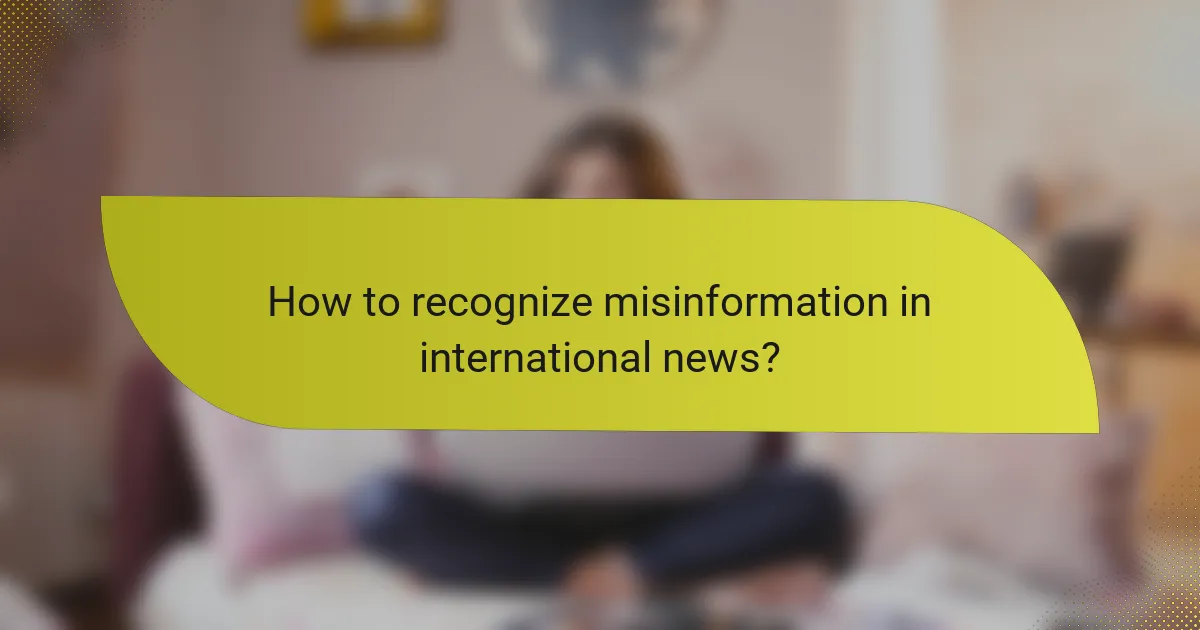
How to recognize misinformation in international news?
Recognizing misinformation in international news involves critically evaluating sources, checking facts, and being aware of common tactics used to spread false information. By understanding these elements, readers can better discern credible news from misleading narratives.
Common misinformation tactics
Misinformation often employs tactics such as sensationalism, emotional appeals, and cherry-picking data. Sensational headlines may exaggerate facts to provoke strong reactions, while emotional appeals can manipulate feelings rather than provide objective information.
Another common tactic is the use of anonymous sources or unverifiable claims, which can create a false sense of authority. It is crucial to question the reliability of such sources and seek out information from established, reputable outlets.
Red flags in reporting
Several red flags can indicate potential misinformation in reporting. Look for articles that lack citations or provide vague references to sources. If a piece relies heavily on emotional language or presents one-sided arguments without counterpoints, it may be biased or misleading.
Additionally, check the publication date and context of the information. Outdated reports or those taken out of context can distort the truth. Always cross-reference with multiple credible sources to verify the accuracy of the information presented.

What frameworks can guide news source evaluation?
Evaluating news sources is crucial for ensuring the credibility of information. Frameworks like the CRAAP test and the SPJ Code of Ethics provide structured approaches to assess the reliability and integrity of news outlets.
CRAAP test (Currency, Relevance, Authority, Accuracy, Purpose)
The CRAAP test is a widely used method for evaluating news sources based on five criteria: Currency, Relevance, Authority, Accuracy, and Purpose. Each criterion helps determine the reliability of the information presented.
- Currency: Check if the information is up-to-date. Timeliness is essential, especially for international affairs where situations can change rapidly.
- Relevance: Assess whether the content is pertinent to your needs. Consider the target audience and the context of the news.
- Authority: Investigate the source’s credibility. Look for authors with expertise in international affairs or reputable organizations.
- Accuracy: Verify the information against other reliable sources. Look for citations and evidence supporting the claims made.
- Purpose: Understand the intent behind the information. Determine if the source aims to inform, persuade, entertain, or sell.
SPJ Code of Ethics
The Society of Professional Journalists (SPJ) Code of Ethics outlines principles that journalists should follow to maintain integrity in reporting. This code serves as a guide for evaluating the ethical standards of news sources.
Key principles include seeking truth and reporting it, minimizing harm, acting independently, and being accountable. When assessing a news source, consider how well it adheres to these ethical standards.
For example, a source that prioritizes transparency and accountability is likely more credible. Look for disclosures about funding, potential biases, and corrections of errors to gauge adherence to the SPJ Code.
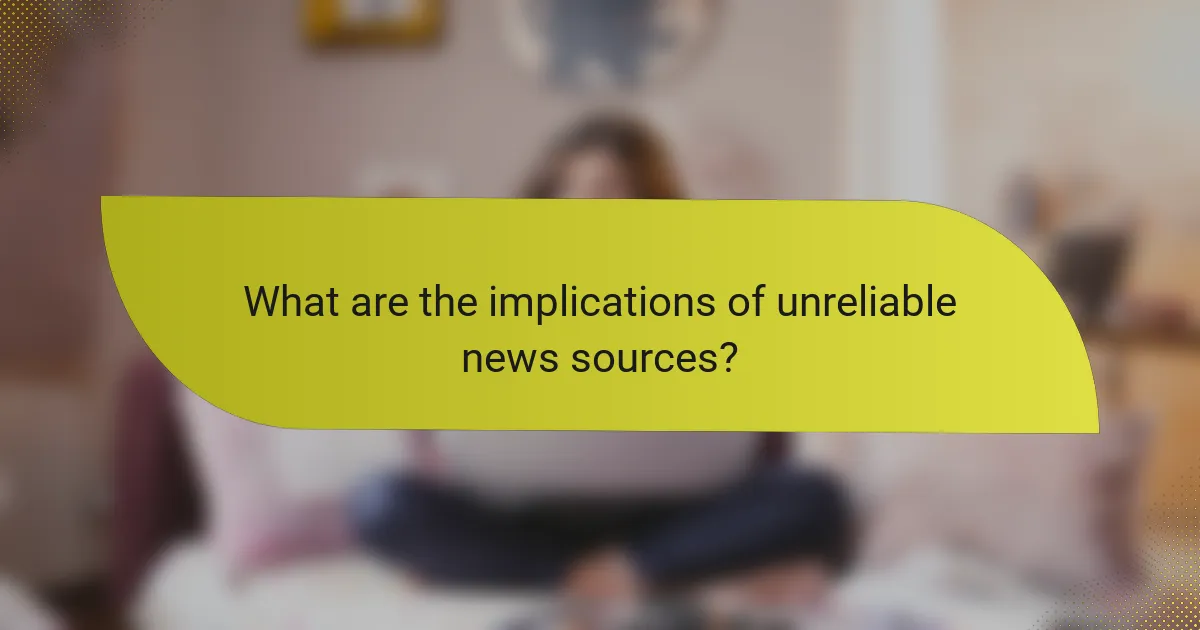
What are the implications of unreliable news sources?
Unreliable news sources can significantly distort public perception and understanding of international affairs. Misinformation can lead to misguided opinions, poor decision-making, and a lack of trust in legitimate media outlets.
Impact on Public Opinion
Unreliable news sources can shape public opinion by spreading false narratives or biased information. This can create polarization, where individuals align with extreme viewpoints based on misleading reports. For instance, sensationalized coverage of international conflicts may incite fear or anger, influencing how communities respond to global events.
Consequences for Policy Making
When policymakers rely on unreliable news, they may make decisions based on inaccurate information. This can lead to ineffective or harmful policies, especially in areas like foreign relations or national security. For example, a government might escalate tensions with another country due to misreported events, potentially leading to diplomatic crises.
Effects on Trust in Media
Frequent exposure to unreliable news can erode trust in all media, making it difficult for credible sources to convey important information. As audiences become skeptical, they may disregard legitimate news, which can hinder informed public discourse. This decline in trust can create a cycle where misinformation thrives, further complicating the media landscape.
